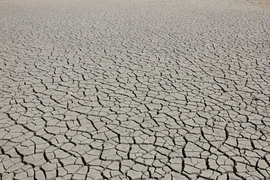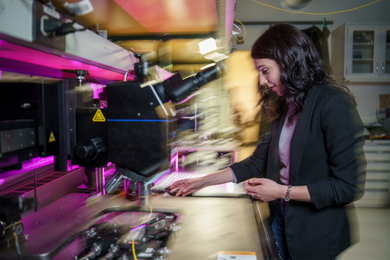The Department of Civil and Environmental Engineering's ninth annual Research Speed Dating event featured a well-rounded display of research from both civil and environmental engineering disciplines, from human microbiomes, carbon partitioning of plants, climate change, and urban pollution to recovering from major storm damage, algorithms for car-sharing networks, and integrating autonomy into transportation systems. The Feb. 15 event brought together a wide range of faculty, research scientists, postdocs, graduate students, and undergraduates to present their research findings.
Assistant Professor Tami Lieberman kicked off the event by highlighting her research that investigates how to add a microbe to an already established microbiome. Lieberman conducts her research through the lens of evolution, using DNA sequencing in order to identify how bacteria spreads between people, and how it is evolving within humans as they coexist with other adapted mutations.
Lieberman, who is one of the department’s newest faculty members, explained that she is searching for expertise within lipid characterization, directed evolution, DNA, large data, and high-throughput microbiology. Her lab plans to explore many different areas such as the colonization of new bacterial strains, disease-specific adaptation, colon cancer, host-specificity, and immune responses to bacteria and probiotics.
Switching gears from the world of microbiomes to the biosphere was PhD student Josh Moss in Professor Jesse Kroll’s lab. The Kroll lab studies atmospheric chemistry, and Moss’ research is concerned with various aspects of urban pollution, such as how smog forms, the reactions of certain chemicals in the atmosphere, and secondary organic aerosol.
“When discussing smog, we talk about it in terms of secondary organic aerosol, and look at what humans and the biosphere emit as primary gasses that react in the atmosphere with oxidants such as OH radical and ozone to form secondary gases. They tend to either form new particles or they will condense onto existing particles to create smog; the mixture of particles and gasses which forms in the presence of UV light,” Moss explained.
Incorporating computer modeling in conjunction with physical experiments in the lab has elicited many exciting opportunities to explore new avenues within his discipline, Moss said.
Moving the discussion from urban pollution to plant biology was Assistant Professor Dave Des Marais, who gave his talk on how plants respond to environmental stressors. He discussed how climate change is impacting growing seasons and is seeking ways to understand these issues. He explained that there is a lot of opportunity for collaboration and research within this field, including the chance to work with a lab in Israel to study numerous variables over time.
Incoming Gilbert W. Winslow Assistant Professor Cathy Wu, who will officially begin her position in CEE this June, switched gears and introduced the audience to the world of transportation. Wu’s research is centered around the integration of autonomy into transportation systems.
She said she aims to challenge conventional transportation systems by looking at the ways in which technology will influence certain systems for the better, making a difference in the long run. Wu came to the realization that researchers do not have a strong understanding of the potential impact autonomous vehicles could have on society.
“These vehicles can potentially provide access to one third of the population including the youth, the elderly, and the disabled. So, I set out and studied robotics, and then became determined to understand the impact of autonomous vehicles on the transportation system,” said Wu.
Wu’s interest in transportation continues to grow. “In the U.S, we have 37,000 traffic accidents each year, it is the leading cause of death in young people, and a vast majority of these accidents are caused by human error,” she explained. “Additionally, we waste 7 billion hours from people sitting in traffic each year, and more than a quarter of greenhouse gas emissions comes from transportation.”
Wu is investigating transportation through deep reinforcement learning — learning policy in order to maximize reward — simulations, and flow traffic LEGO blocks. Moving forward, she is interested in two technical aspects, reliability and scalability in terms of the types of decisions that can be made for urban systems. “There are so many rich perspectives in this department, and I am excited to see the interplay of this when it comes to decision-making,” concluded Wu.
Graduate student Andrew Feldman, who later went on to receive the best lightning talk award, presented on water exchange patterns in the soil-plant continuum based on SMAP Microwave Satellite Measurements. Feldman works with Bacardi Stockholm Water Foundations Professor Dara Entekhabi’s lab to study soil moisture and vegetation water content observations from NASA’s SMAP satellite in order to evaluate plant water storage changes following rainfall.
New to the event this year was a panel discussion on the future of research in infrastructure and environment, moderated by Leon and Anne Goldberg Professor of Humanities, Sociology, and Anthropology Susan Silbey. Silbey serves as chair of the MIT faculty and is also a professor of behavioral and policy sciences within the MIT Sloan School of Management.
“As a social scientist, I have a logical interest in the physical platform of social life, that is the natural and built environment within which social action takes place,” explained Silbey. “My research aims to understand how and when environmental, health, and safety regulations are more or less successful in managing hazards. More specifically, I study how management systems are introduced to control environmental, health, and safety hazards in laboratories. It seems to me my work and CEE addresses the same or overlapping phenomena.”
The panel included CEE Professor Colette Heald, Paul M. Cook Career Development Assistant Professor Benedetto Marelli, JR East Professor of Engineering Professor Ali Jadbabaie, and Breene M. Kerr Professor Elfatih Eltahir.
The discussion covered crucial topics such as the challenge of connecting engineering disciplines with the humanities in order to accomplish more as a society. A recurring issue that was brought up by the panel was how the department intends to solve environmental problems.
“The climate is evolving and changing and there are increasing needs for adapting to that new climate, involving infrastructure in a major way. How do we engineer a process of societal adaptation? I think we are in a unique position as a department to address this concern,” said Eltahir.
Heald supported that argument. “A National Academy of Sciences report about the future of engineering explained that the 20th century was regulation-driven, and the 21st century will be challenge-driven,” she said. “I think this is a great way to think about our department.”
Heald and Eltahir agreed that the diversity of the department places CEE in a unique position to capitalize on the expertise available when tackling global issues. “Our diverse knowledge is beneficial when taking on climate change, and we can provide opportunity in various disciplines including infrastructure, systems, and the environment,” said Heald.
Eltahir explained that having a connection to the social sciences would be something that the department should consider seriously. He emphasized the challenge of consumerism, as a cultural and societal problem throughout the U.S, Europe, and China. “We live in a world that has limited resources, and the global society behaves with the implicit assumption that there are no limits,” explained Eltahir.
“I thought it was a very interesting and thought-provoking afternoon; I think lots of departments, labs, and centers should stage such inviting and informative events,” said Silbey.
The final portion of the evening included a digital poster presentation, which encouraged networking and collaboration between researchers in the department. More than 20 students, ranging from first-year students to postdocs, presented their digital posters.
Postdoc Fabiola Sanchez won honorable mention for her poster about the dynamics of the active-growing bacterial community in the estuarine environment during a 24-hour period. Her poster explains that the active community is different from the total, and its abundance exhibits a strong correlation with the chlorophyll levels and the day-night cycle.
The runner up, senior Stephanie Chin, presented a poster about analyzing noisy data with limited training data, based on a CNN approach, for the specific application of a traffic surveillance camera. This approach could help adapt general-purpose models for domain-specific content and applications, such as traffic surveillance images.
PhD student Isabelle Su’s winning poster, “Exploring a Spider Web’s Structure with Sound,” explained the use of sonification in order to visualize complex 3-D spider web data through sound. Su created an interactive sonification model that can be used as a versatile data exploration tool, for instance, to find spider web patterns, as a creative platform or recreated for similar data networks.
After announcing the prizes, the night concluded with a dinner for the participants and their colleagues, allowing for further networking opportunities. Inspiring research talks, a panel discussion, and digital poster presentation session successfully displayed the bright future that CEE has ahead.
“Research speed dating gives the community of students, postdocs, staff, and faculty an opportunity to present their research and collaborative opportunities to their colleagues,” said McAfee Professor of Engineering and department head Markus Buehler. “The panel addressed many issues regarding climate change and efforts that call for numerous disciplines to come together when addressing critical challenges of infrastructure and environment. This event certainly highlighted the inspiring research that intends to solve the imperative large-scale societal issues of today, where science and engineering play a crucial role.”














